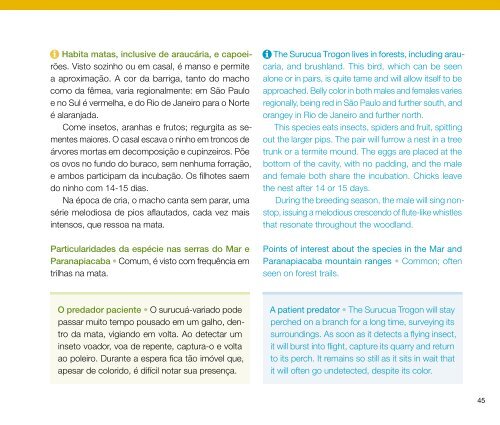Guia de aves Mata Atlântica Paulista - Secretaria do Meio Ambiente
Guia de aves Mata Atlântica Paulista - Secretaria do Meio Ambiente
Guia de aves Mata Atlântica Paulista - Secretaria do Meio Ambiente
You also want an ePaper? Increase the reach of your titles
YUMPU automatically turns print PDFs into web optimized ePapers that Google loves.
Habita matas, inclusive <strong>de</strong> araucária, e capoeirões.<br />
Visto sozinho ou em casal, é manso e permite<br />
a aproximação. A cor da barriga, tanto <strong>do</strong> macho<br />
como da fêmea, varia regionalmente: em São Paulo<br />
e no Sul é vermelha, e <strong>do</strong> Rio <strong>de</strong> Janeiro para o Norte<br />
é alaranjada.<br />
Come insetos, aranhas e frutos; regurgita as sementes<br />
maiores. O casal escava o ninho em troncos <strong>de</strong><br />
árvores mortas em <strong>de</strong>composição e cupinzeiros. Põe<br />
os ovos no fun<strong>do</strong> <strong>do</strong> buraco, sem nenhuma forração,<br />
e ambos participam da incubação. Os filhotes saem<br />
<strong>do</strong> ninho com 14-15 dias.<br />
Na época <strong>de</strong> cria, o macho canta sem parar, uma<br />
série melodiosa <strong>de</strong> pios aflauta<strong>do</strong>s, cada vez mais<br />
intensos, que ressoa na mata.<br />
Particularida<strong>de</strong>s da espécie nas serras <strong>do</strong> Mar e<br />
Paranapiacaba • Comum, é visto com frequência em<br />
trilhas na mata.<br />
The Surucua Trogon lives in forests, including araucaria,<br />
and brushland. This bird, which can be seen<br />
alone or in pairs, is quite tame and will allow itself to be<br />
approached. Belly color in both males and females varies<br />
regionally, being red in São Paulo and further south, and<br />
orangey in Rio <strong>de</strong> Janeiro and further north.<br />
This species eats insects, spi<strong>de</strong>rs and fruit, spitting<br />
out the larger pips. The pair will furrow a nest in a tree<br />
trunk or a termite mound. The eggs are placed at the<br />
bottom of the cavity, with no padding, and the male<br />
and female both share the incubation. Chicks leave<br />
the nest after 14 or 15 days.<br />
During the breeding season, the male will sing nonstop,<br />
issuing a melodious crescen<strong>do</strong> of flute-like whistles<br />
that resonate throughout the woodland.<br />
Points of interest about the species in the Mar and<br />
Paranapiacaba mountain ranges • common; often<br />
seen on forest trails.<br />
O preda<strong>do</strong>r paciente • O surucuá-varia<strong>do</strong> po<strong>de</strong><br />
passar muito tempo pousa<strong>do</strong> em um galho, <strong>de</strong>ntro<br />
da mata, vigian<strong>do</strong> em volta. Ao <strong>de</strong>tectar um<br />
inseto voa<strong>do</strong>r, voa <strong>de</strong> repente, captura-o e volta<br />
ao poleiro. Durante a espera fica tão imóvel que,<br />
apesar <strong>de</strong> colori<strong>do</strong>, é difícil notar sua presença.<br />
A patient predator • The Surucua Trogon will stay<br />
perched on a branch for a long time, surveying its<br />
surroundings. As soon as it <strong>de</strong>tects a flying insect,<br />
it will burst into flight, capture its quarry and return<br />
to its perch. It remains so still as it sits in wait that<br />
it will often go un<strong>de</strong>tected, <strong>de</strong>spite its color.<br />
45

















